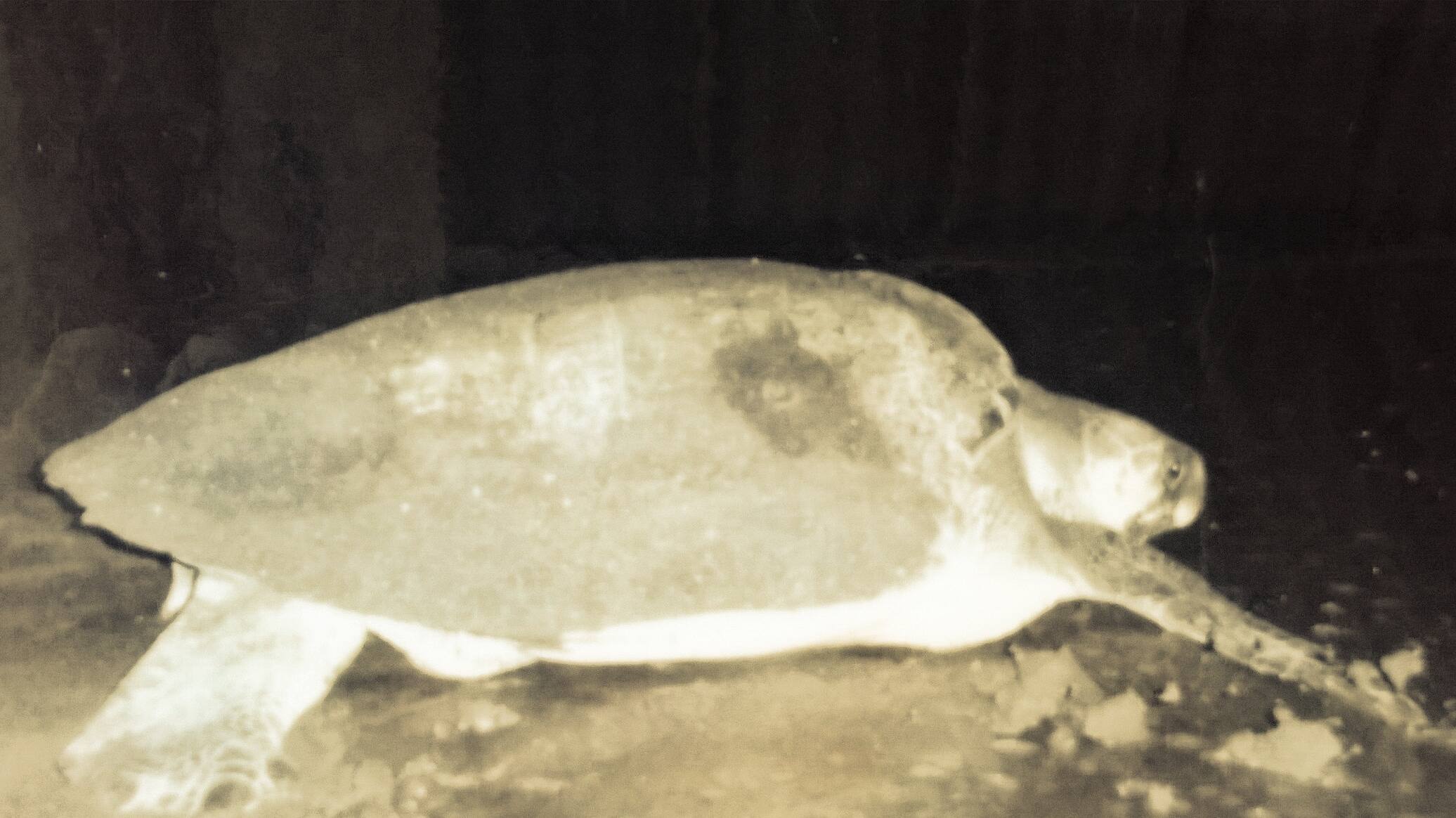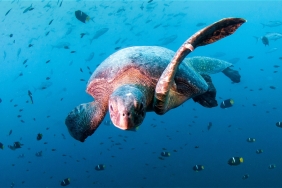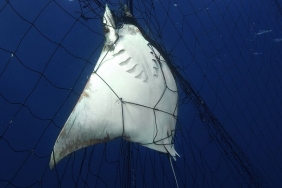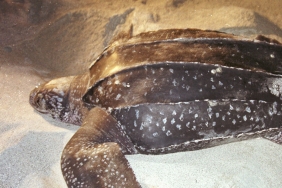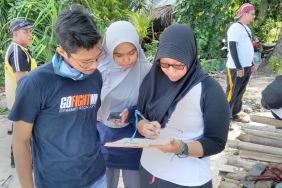THE POOR OLIVE RIDLEY TURTLE
(12/4) Like the previous nights, the WWF-Indonesia enumerator team went down to the turtle nesting beach to monitor the turtles that came up to the beach to lay their eggs. Similarly, Salem - Enumerator in Wamlana Village has prepared to carry out his duties with a flashlight in hand. Salem also equipped himself with a tape meter to measure morphometry or the length of the turtle's carapace arch, sampling tools, a tool to attach pit tags and others stored in a waterproof bag. This activity has been going on for almost four years since 2017 in Waenibe, Waspait and Wamlana Villages in Fena Leisela District, Buru Regency, Maluku. Based on monitoring data in previous years, it is known that April to May is the peak nesting season for Olive Ridley Sea Turtles (Lepidochelys olivacea).
The chill of the night, the roar of the waves and the breeze accompanied Salem's monitoring. Luckily, this night the moonlight was bright enough to increase his visibility, so he did not use a flashlight too often when walking on the beach because sea turtles are very sensitive to light. The presence of light can frighten turtles that want to lay eggs, thus making turtles discourage their intention to lay eggs at that location. Salem conducts night monitoring from 21.00 - 04.00 WIT by walking along the beach along 4.42 km of the total monitoring area of 12.7 km. Salem then stands guard at a location that is a turtle nesting hot spot area. This night monitoring is conducted to obtain morphometric data of turtles that come to lay eggs, collect skin tissue samples to determine genetic information of turtles, and secure nests from human and predator threats. Night monitoring also aims to observe individual turtles laying eggs. If turtles are found laying eggs below the highest tide or in locations that are vulnerable to loss from predators and humans, the eggs will be relocated to a safer place according to procedure.
Salem went down to the beach to the east, which borders his partner's monitoring area in Waspait Village. Not long after Salem walked, he saw a sea turtle pawing the sand not far from the residential area. As soon as possible, Salem approached the turtle's location. An individual Olive Ridley sea turtle was digging a body pit. The digging of the body pit is done to keep the turtle comfortable during the nest-making process. The turtle makes a body pit with its flippers and moving body to form a hole of the appropriate size to support its body during the nesting process.
When taking measurements, Salem noticed something strange about this Olive Ridley Turtle: its carapace had several large defects that looked like it was about to disintegrate. The condition was very worrying, the back of the left and right carapaces were broken and detached, and there were two large crescent-shaped scratches ± 25 cm long and 10 cm wide on the left side of the carapace. In addition, there were cracks that almost filled the carapace and crustaceans were found attached to the inside of the carapace. Salem, who felt strange at the time, immediately contacted Rendra, who was the coordinator of enumerators in the field. The two of them could only document the condition of the damaged carapace while taking morphometric measurements and confirming it with fellow turtle experts through the whatsapp discussion group. From the morphometric measurements, it was found that the Olive Ridley Turtle has a carapace arch length of 63 cm and a carapace arch width of 65 cm. This Olive Ridley turtle also has a footprint width of 68 cm.
The result of documentation analysis, drh. Maulid Dio Suhendro, M.Si, one of the administrators of IAM Flying Vet (Indonesian Association of Aquatic Megafauna Veterinarians) explained that the Olive Ridley Sea Turtle found nesting on North Buru Island had a carapace fracture (carapace fracture) on the tail (posterior) back and shell injury (large shell injury) in the form of a cut wound (vulnus insivum) on the upper middle carapace (dorsal carapace). It is suspected that the injuries were from two different incidents, with the broken carapace bone on the hind tail thought to have been caused by a bite from a large predator such as a shark or crocodile. This is inferred based on the shape of the deep wound and the irregular fracture, which is thought to be the result of defense interactions with a two-way pulling force, causing a fracture in the back of the carapace. This wound causes infection and parasites are usually found attached to the wound. While the wound on the flipper is thought to come from the incision of hard and sharp objects, such as ship propellers. Given that sea turtles often come to the surface of the sea to breathe, it is inevitable that there is a possibility of turtles experiencing an instant impact if a ship passes nearby. These two incidents are thought to have occurred during the turtle's migration from feeding habitat to nesting habitat more than a week ago. Nonetheless, like a well-oiled machine, sea turtles will struggle to lay their eggs on the beach when they enter the nesting phase, as part of their reproductive cycle.
The Olive Ridley turtle is the most common turtle species to lay eggs on the turtle nesting beaches of northern Buru Island, followed by the Leatherback turtle (Dermochelys coriacea)and the Green turtle (Chelonia mydas). Each year, monitoring data shows that the number of Olive Ridley Sea Turtles found landing is always increasing. The number increased from 237 tracks and nests in 2017, to 247 tracks and nests in 2018, and 364 tracks and nests in 2019. The large number of Olive Ridley Sea Turtles that land to lay their eggs are also not free from threats. In 2017, as many as 85% of nests were found to be lost to humans. The number of nests lost to humans dropped dramatically to 28% in 2018. This decline also occurred along with the entry of WWF-Indonesia who made efforts to raise public awareness about the protection status of sea turtles and their benefits to the ecosystem. Unfortunately, not all people are aware of the importance of sea turtles. There are those who are aware that sea turtles are protected by law, but still continue to utilize them. This is shown by the data that in 2019 the number of sea turtle nests lost increased by 8% to 36% from the previous year.
In addition to eggs that are often taken by humans for consumption or trade, there are many other threats that occur. Nests that are about to hatch are attacked by predators such as dogs and monitor lizards, causing them to fail. In addition, some newly hatched hatchlings become prey for crabs and birds. Once the hatchlings enter the seawater, the fish are ready to prey on them. It's not enough to stop there, the tough journey of life for a sea turtle is still experienced when they grow up. Sea turtles are still very threatened to be caught by fishermen either intentionally or unintentionally (bycatch) and consumed by the community. The activity of passing ships is also a threat to sea turtles, such as this case which is likely suspected that the turtle's carapace was damaged by the propeller of the ship's engine (propeller speed boat). The ecological function of sea turtles is vital for the balance in the marine ecosystem.

